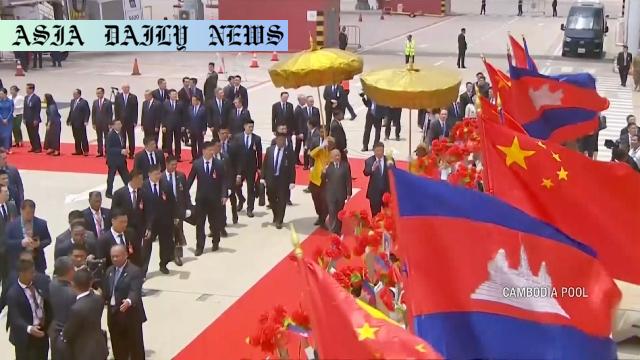Cambodia strengthens its alliance with China as President Xi Jinping concludes his Southeast Asia tour.
Xi Jinping visits Cambodia as the last leg of his Southeast Asia tour.
Meetings with Cambodian leadership emphasize deepening ties.
Xi calls for strong opposition to external forces affecting China-Cambodia relations.
Recent US tariffs on Cambodia add a context of trade competition.

Xi Jinping Concludes Southeast Asia Tour in Cambodia
Chinese President Xi Jinping made his final stop in Phnom Penh, Cambodia, marking the conclusion of his diplomatic journey across three Southeast Asian nations. Preceded by visits to Vietnam and Malaysia, this tour highlights China’s strategic intentions to foster partnerships in the region, particularly against the backdrop of mounting trade tensions with the United States. The Cambodian visit underscores the importance Beijing places on its ties with the country, signaling deeper cooperation on both economic and military fronts.
Strengthening Sino-Cambodian Relations
During his visit, Xi met with former Cambodian Prime Minister Hun Sen, a defining leader for nearly 40 years in Cambodia’s political framework. The Chinese leader also held talks with the incumbent Prime Minister Hun Manet, Hun Sen’s son, further solidifying strong familial and political connections between the two nations. A key aspect of their dialogue revolved around enhancing bilateral relations and fortifying their strategic alliance. Xi emphasized the necessity of “resolutely opposing external influences” that could potentially harm the long-standing China-Cambodia partnership. Such rhetoric demonstrates Beijing’s intention to preserve Cambodia as a crucial regional ally amidst growing tension with the West.
China’s Investments in Cambodia
In recent years, China has significantly boosted its economic and military investments in Cambodia. One notable example is the Ream Naval Base, where new facilities constructed with Chinese funding were recently completed. These developments highlight China’s influence in the region, driving speculation about potential geopolitical ramifications. From infrastructure initiatives under the Belt and Road framework to military partnerships, these investments signal Beijing’s enduring commitment to deepening its foothold in Southeast Asia.
Geopolitical Context: US-China Trade Rivalry
Xi’s visit to Cambodia comes amid escalating trade disputes between China and the United States. Earlier this month, US President Donald Trump imposed a hefty 49% tariff rate on Cambodian goods. While the tariff remains suspended for now, its implications loom large. By strengthening its diplomatic ties and economic partnerships with Cambodia, China positions itself as a reliable ally in contrast to the economic restrictions posed by Washington. This dynamic could reshape Southeast Asia’s political and economic landscape, granting China greater influence over a region historically divided by global power plays.
Conclusion: A Calculated Diplomatic Strategy
President Xi Jinping’s stop in Cambodia marks a calculated and strategic move to further cooperation with a vital ally. As China faces increasing scrutiny and competition from the United States, nurturing closer relationships with nations like Cambodia serves multiple purposes. It not only solidifies Beijing’s presence in Southeast Asia but also sends a strong message to adversaries about its capacity for forming enduring partnerships despite external pressures. This tour demonstrates that China’s focus extends beyond its current challenges, aiming instead for long-term regional and global influence.
Commentary
Understanding the Depth of Xi’s Diplomatic Mission
President Xi Jinping’s visit to Cambodia carries significant diplomatic, economic, and geopolitical weight. As the final leg of his Southeast Asia tour, this trip underscores Beijing’s steadfast commitment to counterbalancing Western influences, particularly amidst growing US-China trade tensions. Xi’s emphasis on strengthening Sino-Cambodian relations is not only a testament to China’s confidence in fostering reliable regional partnerships but also a strategic maneuver to deepen its foothold in Southeast Asia.
The Symbolism of Sino-Cambodian Cooperation
Cambodia holds a symbolic and strategic position for China’s broader regional ambitions. Beyond economic partnership, China’s involvement in projects like the Ream Naval Base exemplifies its intentions to strengthen military cooperation. Such actions likely aim to ensure a dependable ally in Southeast Asia while reinforcing its presence in a geographically pivotal area. It reveals China’s calculated approach to maintaining influence amid geopolitical tension and trade competition with the US.
What Lies Ahead for Cambodia and Its Geopolitical Choices
For Cambodia, remaining an ally of China offers economic incentives and political stability in the short term. However, this partnership comes with its challenges, particularly as the US continues its efforts to assert influence in the region. How Cambodia balances its alliances with major powers like China and the US in the years to come will significantly shape its development and geopolitical role in Southeast Asia. Ultimately, the visit by Xi Jinping affirms that Cambodia will remain a key player in regional politics as the balance of power shifts globally.


